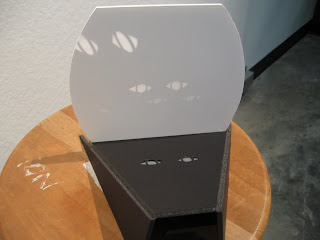Archetype, Prototype, Hybrid-
Looking across the room during our 3D model critique on Friday I found that my model's function did not work and it was very underdeveloped. This is because it was a prototype of what it may one day grow from. The idea of a structure which manipulates light is my archetype, creating the light mechanism and the structure is the prototype, bringing all of those things together to create a cohesive structure is the hybrid. The Romans also sought to manipulate light in domes such as the pantheon in which a cut out hole in the dome became the primary source of light (Roth 178-277).

Source-
In analyzing my fairy-tale for inspiration I found that there is neither a huge emphasis on dark or light characters, that the characters are often gray. I thought about how I could convey that grayness or mood through my 3D structure. I decided on actual light and its manipulation as my source for grayness. having a mirror bounce light from one platform to another vertical platform creates an image of something which has a softness to the lines as well as an untouchable quality. Conveying the mood through the mirroring of mysterious eye cutouts allows the viewer to see how white and black/good and bad are often blurred together in characters and in architecture. Seeing eyes in a shadow is somewhat ethereal, which can also relate to fairy tales in general in that they are from another world but still almost tangible.


Entourage-
An atmosphere and mood is made through its entourage of objects within. The objects within the space give character as well as a mood created through their interaction with color and lighting. The various shapes and sizes of bottles, shelves, lights etc. provides a liveliness and interaction that would be missing if the composition were only comprised of people and a counter.

Hierarchy-
The Greek acropolis was a mountain which brought those worthy in society to enter the acropolis to be closer to the gods (Roth 178-277).
Order-
The citadels within Greece and Rome were ordered with three basic parts in mind the porch hearth and court. This Trio of order also extends to subdivisions of the city such as the acropolis and then to houses. The MHRA building on our UNCG campus is ordered much the same way in that there is a grand entrance (porch) leading to a gathering area (court), and then within the more sectioned off parts of the building are the central offices (hearth).

Reflection-
The Order of three can be found in many facets of architecture. In the way of design there is Archetype, Prototype, and Hybrid. With each step along this tripartite there is a greater hierarchy of development in that styles are refined and the people who inhabit these refined structures are at the top of their society.
Citations-
Roth, Leland (2007). Understanding Architecture. Westview Press.


1 comment:
Wow, nice drawings! Seriously impressed by the use of color. Hmmm... but the citations need work. Ideally they should be tacked on at the end of a paragraph; rather, they become more relevant when you work them in with your original text and create a seamless transition between ideas, both in a syntactical and theoretical way! I'd enjoy it if you expanded more on your ideas... I realize you don't have to write a whole lot but I imagine you can pack a little more punch.
About the MHRA-- this building really bothers me! While I like the interior, especially around the area you describe as the court [that material on the west wall is really awesome], I feel like it's a bit... misguiding. For one, its grand entrance you reference faces nothing really important-- that corner is seriously neglected. What kind of design language is that? Plus I'm not fully convinced that the hearth would be the classrooms and offices, but if you explained more I'm sure I could be swayed. ;)
Post a Comment